-

人教版新目标初中英语七年级下册It’s raining教案2篇
1 Each group choose one place to describe and what you are doing in it Choose one place, and describe what they are doing 2 Move around the room and give suggestions Talk about it and write it down 3 Ask one to show their works and act it Choose one of each group to make a report 4 Evaluate the best group and the best reporter Choose the best one Homework Ask your friends their ideal place and write about it教学反思:新课程标准中强调学生在课堂中的主体地位,在综合课中他们的主体地位就更加突出。在各个活动中给不同程度的学生不同层次的任务,让各层面的学生都有表现发挥的机会,从而产生对英语的兴趣。使用照片图片多媒体来辅助教学,效果更好。同时让了解其他国家风景,风俗的同学介绍ideal place,增加学生的背景知知识,实现跨学科交流的目的。教案点评:采用任务型教学模式,在各个活动中给不同程度的学生不同层次的任务,让各层面的学生都有表现发挥的机会,从而产生对英语的兴趣。使用照片图片多媒体来辅助教学,效果更好。让了解其他国家风景,风俗的同学介绍ideal place,增加学生的背景知识,实现跨学科交流的目的。

人教版新目标初中英语七年级下册Why do you like koalas教案2篇
单元整体说明(一)单元教材分析本单元的核心话题是描述动物和表达个人喜好,以及句式why do you like…? Because…。这也是本单元的教学重点。通过本单元的学习,学生应能较流利地运用所学词汇和句型描述动物,表达个人喜好。(二)单元知识结构1.词汇动物名称 tiger, elephant, koala, dolphin, etc.词汇描述性形容词: smart, cute, ugly, clever, shy, etc.国家名: Australia, South Africa2.句型Why do you like koala hears? Because they are cute.Where are pandas from? They're from China.What animals do you like? I like dolphins.(三)单元整体目标1.Master the vocabulary2.Master and use: Why do you like koalas? Because they am cute.Where are pandas from? They're from China.What animals do you like? I like dolphins.(四)单元教学重难点一览(五)单元学情分析学生此前已经学过由why, where, what 引导的特殊疑问句句型,具有了学习本单元知识的认知前提。形形色色的动物能激发学生的好奇心,产生了解它们的欲望,这有利于本单元知识的教学和学生学习兴趣的培养。

人教版新目标初中英语七年级下册How was your weekend教案2篇
Teaching Goal:1. General aims:Talk about recent past events2. Particular aims:A. Language Focus.Talk about recent past events and think of the past events.B. Language goalsHow was….?It was …What did …do over the weekend?C. Language structures:(1). How was your weekend? I was great. Pay attention to no form.(2). What did you do over the weekend? I played soccer. We went to the beach.D. Useful words and phrases:Words: was, did, went, beach, over, project, test, wasn’t, false, number, geography, spend, week, most, mixture, their, had, little, cook, read, saw, change, everyone, sit, sat, no, anythingPhrases: did one’s homework, played soccer, cleaned my room, went to the beach, played tennis, went to the movies, on Saturday morning, over the weekend, cook … for, what about, do some reading, have a party, talk show, go shoppingE. Grammar language:Present simple past tenseRegular and irregular verbsF. Learning strategies:Tour and holidaysG. Interdiscipinary:H. Emotion and manner:Teaching time: 5 periodsTeaching procedures:Period One教学步骤、时间 教师活动 学生活动 媒体应用Step 1Free talk 3’ Ask some questions like:Who’s on duty today?What’s the weather like? Answer and talk about something.让同学们回答下列问题1. Do you like weekend? (Let some students answer)It takes them three minutes to talk about the question.2. Why do you like weekend? (let the students answer) Most of the students like the weekend此时教师用汉语问:“在周末期间问你干了什么?这句话用英语这么回答?Let the students guess.At last the teacher give them right answer3. What did you do over the weekend?(板书、学习)

人教版新目标初中英语七年级下册Where is the post office教案2篇
Period 2 (3a----Section B 2c)Preview(Pre-task): Key points: What laAdd another information about their pen pals----their language on the cardnguage does she/he speak?She/He speaks....Does she/he have any brothers and sisters? Does she/he speak English?Preview(Pre-task): Add another information about their pen pals----their language on the cardKey points: What language does she/he speak?She/He speaks....Does she/he have any brothers and sisters? Does she/he speak English?Step 1 Revision1.Revisionand dictation of the new words 2.Revise the drills they learned yesterday.(by pairwork and grammar exercise)Step 2 Leading-inT has a conversation with one student. The conversation is following:---Do you have a pen pal?---Yes, I do.---What's your pen pal's name? ---His/Her name is....---Where is your pen pal from? ---He/She is from...---Where does he/she live? ---He/She lives in....---What language does he/she speak?He/She speaks...Write the new words on the Bb. They are following: EnglishChineseJapaneseFrenchStep 3 LearnLearn the new words with the whole class.Finish 3a with the students3b Pairwork T still does an example with one student Then the Ss practise in pairs. The example is following:--Curry Muray is my pen pal. He is from the United States.---What language does he speak?

人教版新目标初中英语七年级下册I want to be an actor教案2篇
三、教学建议第一课时:1. Lead in (Vocabulary)A) Before class, teacher should collect some pictures of working places. For example: Bank, TV Station, Restaurant, Police Station, Hospital ...B) In class, show students the pictures (PowerPoint, OHP). Ask students to tell the name of the working places and the name of the jobs.Shop assistant, doctor, actor, reporter, police office, waiter, bank clerk, studentC) Do exercise 1a and 3a.2. Bingo GameAsk groups of students to make up pairs of cards with a job on one and the related workplace on the other. For example, waiter / restaurant, teacher / school, doctor / hospital. Encourage students to use both the job / workplace combinations in the book and the ones that students came up during class discussions. Be sure they have twice as many sets of cards as there are students in the group. They can make two sets of cards for a single job / workplace, if necessary. Then have each group mix up its set of cards and hand their cards out in random order. Each time a student gets a pair of cards that match, he or she can lay these cards down. The goal is to have no cards in your hand at the end.3. Task OneA) Ask students to work in pairs and ask the partner what does he / she want to be in the future.e. g. :What do you / does he / does she want to be?I want to be a.Why?Because it's (adj).B) Vocabulary: Section B, 1a4. Homework 1.2.
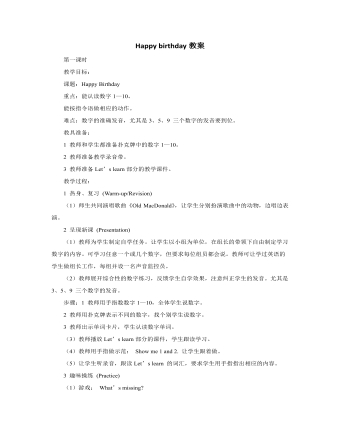
人教版新课标PEP小学英语三年级上册Happy birthday教案
(2)猜猜看每次请一个同学在黑板上画一种刚学到的物品,他每画一笔,就请班上的同学用英语猜他画的是什么。如猜得正确,就请下一位同学再重新开始画另一种物品。(3)Let’s rhyme.将所学的单词替换第一单元的Let’s chant中的文具。教师将全班分为两大组,教师举图片提示,如第一组说:I have a balloon.第二组一起说:Me too. 拍手,举第二幅图时两组交换。以此类推。(4)教师将单词的图片先面朝上贴在黑板上,给学生20秒时间记住这些单词,然后每张图卡用1张彩色纸盖上。学生要先说出彩色纸的颜色,再说出下面卡上的词。待学生熟悉后,可加大游戏难度,将盖着彩色纸的图卡在(黑板上)打乱,进行游戏。(5)让学生听录音,边说边做Let’s do部分的活动。(6)教师将Let’s do中的图卡打乱顺序,贴在黑板上,教师说一个指令,请学生指出正确的图片。正确的可为本组赢一分。

人教版新课标PEP小学英语三年级上册Hello!教案4篇
(3)通过游戏Simon says 来练习以show, open, close, put, carry 所引导的祈使句。教师发指令学生做动作。但只有听到老师带有Simon says的指令时,才能做出相应的动作,否则就是失败。失败的同学退出游戏。(4)听Let's chant的录音,学生边听边做,逐渐过渡成边听边说边做,最后独立说做,并进行比赛。4. 课堂评价(Assessment)做活动手册本单元第5部分练习。学生根据录音,圈出所听到的文具。具体方法和步骤参考如下:(1)学生看图,用英语说出图中每样文具物品。(2)教师讲解题目的意思并指导做的方法。(3)学生听录音做练习。(4)再放录音,在教师的指导下让学生一句一句地跟读并互相核对答案,并说出所圈的文具,再通过给花朵涂色进行自我评价。5. 扩展性活动(Extensive activities)选词游戏。将学生分为六组,每组各派一个选手,教师说单词,选手快步跑到讲台前,找到所说单词,并举起大声读出,正确为胜。
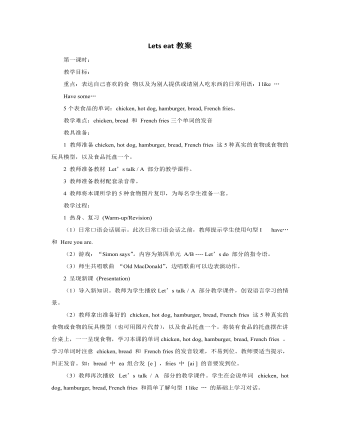
人教版新课标PEP小学英语三年级上册Lets eat教案
教师将本课A、B部分所学单词的图片卡贴在黑板上,找两个学生各手持一把新苍蝇拍,教师读出一个单词,学生就要马上找出来并拍立一下。第一个拍的学生获胜。(4)教师准备一个小场景:将所有学过的食品及饮料或模型放在一个铺着台布的桌上,请学生根据A、B部分的Let’s talk进行自由会话。2.新课展示(Presentation)(1)本课时Let’ s learn中的单词认读教学,可继续采用A部分第二课时的教学方法,利用课件,让学生利用已掌握的拼读规则,认读和学习新单词。(2)让学生听Let’s learn的录音,一边听,一边指着书上相应的图,力求做到“眼到,手到,口到,心到”。(3)用一组连贯的动作教Let’s do中的动词Pour,smell,taste,drink。首先,教师左手端着一个茶壶,右手拿一茶杯,对全班说:Look!I’m pouring the tea. Pour the tea.(边倒茶,边说两遍)。
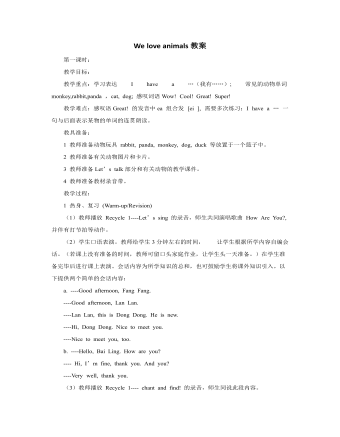
人教版新课标PEP小学英语三年级上册We love animals教案
(1)游戏:向它那儿跑去(Run to it!)首先,用图片和词卡练习本课的6个新单词。学生边读老师边把卡片贴在黑板上。将全班分成两队。给学生下一个Run to the bird.这样的指令。每队的第一个学生向带有鸟的图卡和词卡的地方跑,并且用手摸一下这两张卡片。哪组学生先摸到卡片就给他们队得一分。教师也可以用本课刚学的指令:Walk to….Jump to ….Fly to….等指令学生用相同的动作走(跳,飞)到卡片前。(2)教师将Let’s do的图片打乱顺序,让学生听指令,选出正确的图片。(3)游戏:照我说的做(Do as I say)教师发指令,全班同学起立做动作。做错的同学随时坐下。最后,哪组站着的同学多,哪组获胜。教师参考指令: Climb like a monkey/bear.Jump like a squirrel/rabbit.Walk like an elephant/duck.Hunt like a mouse/pig.Act like a cat/dog.Fly like a bird.为了增加游戏的难度和趣味性,教师可逐渐加快指令的速度。4.课堂评价(Assessment)做活动手册本单元第5部分的练习。方法和步骤参考第一单元。
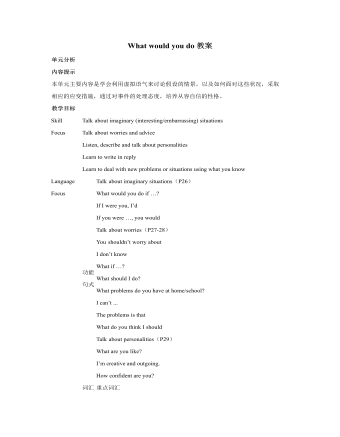
人教版新目标初中英语九年级上册What would you do教案
本课采用任务型教学法,用What would you do if you had a million dollars?这个问句,引出谈论假想情况的话题。 采用提问、启发和归纳的教法,让学生易于接受教材内容,培养学生的语言运用能力。 四、 教学过程设计 Step Ⅰ. Greet the whole class as usual. Step Ⅱ. Warming-up T: Do you have ten Yuan in your pocket? S1: No, I don’t. T: (Take out ten Yuan and give it to the student) OK, never mind. What would you do if it was yours? What would you do if you had ten Yuan? S1: I would buy snacks. T: OK, thank you. Sit down, please. (To the whole class) Just now, it was only ten Yuan. What about 100 Yuan? What would you doif you had 100 Yuan? S2: I’d buy a beautiful jacket. T: Thank you. (To the whole class) Now suppose you had a million dollars, what would you do? We know thatone dollar nearly equals eight Yuan, so that’s a large sum of money. Think it over carefully and tellme your ideas. What would you do if you had a million dollars? S3: I’d buy a big house. S4: I’d buy a sports car. S5: I’d put it in the bank. T: OK, stop here. Please look at the blackboard and guess what would I do if I had a million
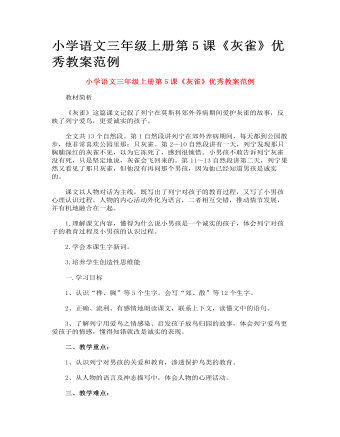
小学语文三年级上册第5课《灰雀》优秀教案范例
教材简析 《灰雀》这篇课文记叙了列宁在莫斯科郊外养病期间爱护灰雀的故事,反映了列宁爱鸟,更爱诚实的孩子。 全文共13个自然段。第1自然段讲列宁在郊外养病期间,每天都到公园散步,他非常喜欢公园里那:只灰雀。第2—10自然段讲有一天,列宁发现那只胸脯深红的灰雀不见,以为它冻死了,感到很惋惜。小男孩不敢告诉列宁灰雀没有死,只是坚定地说,灰雀会飞回来的。第11~13自然段讲第二天,列宁果然又看见了那只灰雀,但他没有再问那个男孩,因为他已经知道男孩是诚实的。 课文以人物对话为主线,既写出了列宁对孩子的教育过程,又写了小男孩心理认识过程。人物的内心活动外化为语言,二者相互交错,推动情节发展,并有机地融合在一起。
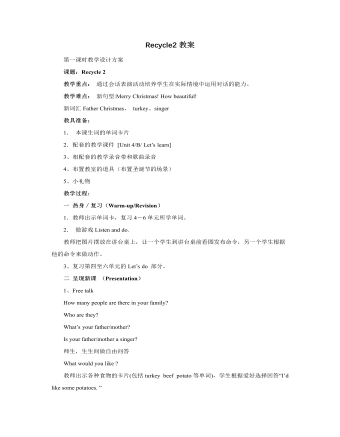
人教版新课标PEP小学英语四年级上册Recycle2教案
二 呈现新课 (Presentation) 1、pass the word 两个小组听音乐同时向后传词卡,一组传成员,一组传职业。音乐停后,拿成员的学生问另一人,如:“What’s your father? My father is a doctor.” 2、group work 两人一小组,互问答,学生根据对方的回答摆词卡。 根据卡片,用句子描述一下自己的家庭成员和职业。(仿照歌谣中的句型) 3、Listen and match 听一听Chant,请孩子们根据录音摆一摆卡片。一个学生在黑板上摆。 4、观看课件,边看边跟读。看书,边看边指书中的人物。 5、听录音,边听边打节奏。男女生接龙说歌谣。各小组接龙说歌谣。请几个学生接龙说歌谣。6、各小组说一说,演一演歌谣。各小组展示歌谣。 7、教师出示一个制作好的圣诞礼物,说:“Do you like it?”“Today let’s make a gift ,ok?”教师边说边示范制作过程。学生认真听,理解。
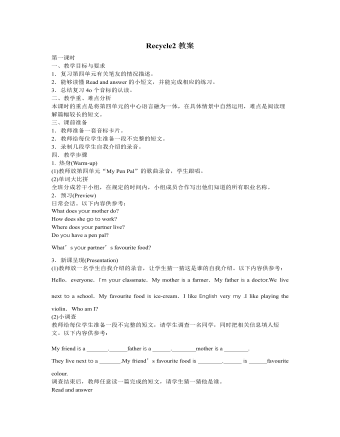
人教版新课标PEP小学英语六年级上册Recycle2教案
2.预习(Preview) 看字母,说职业 教师出示职业名称单词的首字母,让学生说出整个单词。如:w-writer;d-driver/doctor,a-accountant/actor/actress;T-TV reporter等o 3.新课呈现(Presentation) (1)从看字母说职业名称引出TV reporter,教师拿出一些名人照片说:“Now you’re a TV reporter.You’re going to interview a famous person.You don’t know who he/she is .But you know he/she is someone in the pictures.”给学生五次提问的机会,让他们根据教师的回答找出正确的人物。以下问题供参考: What does he/she do? What’s h is hobby ? Is he strong/thin/tall? Where does he/she live? (2)心有灵犀 请两名学生(sl和s2)上来,每人拿着纸和笔分别站在教室的两边。教师提问:“What does s1’s father do?”站在台上的两名学生分别把答案写在各自的纸上。如果两人的答案完全相同,两人就算获胜。教师继续问问题“What does …’s…do?”全体学生一起写出答案,谁写的答案正确就可以得一分。 Listen and match (1)教师说:“Do you want to know more about Liu Yun?’’学生回答后教师说:“Please listen and find out.’’教师放本部分录音,学生认真听。
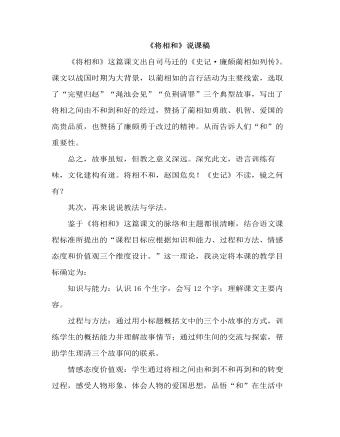
部编人教版五年级上册《将相和》说课稿
鉴于《将相和》这篇课文的脉络和主题都很清晰,结合语文课程标准所提出的“课程目标应根据知识和能力、过程和方法、情感态度和价值观三个维度设计。”这一理论,我决定将本课的教学目标确定为:知识与能力:认识16个生字,会写12个字;理解课文主要内容。过程与方法:通过用小标题概括文中的三个小故事的方式,训练学生的概括能力并理解故事情节;通过师生间的交流与探索,帮助学生理清三个故事间的联系。情感态度价值观:学生通过将相之间由和到不和再到和的转变过程,感受人物形象,体会人物的爱国思想,品悟“和”在生活中的重要性,并以此为跳板,了解中国的“和”文化。教学的重点和难点放在引导学生充分感受文中的人物形象,并且体会到“和”的意义。
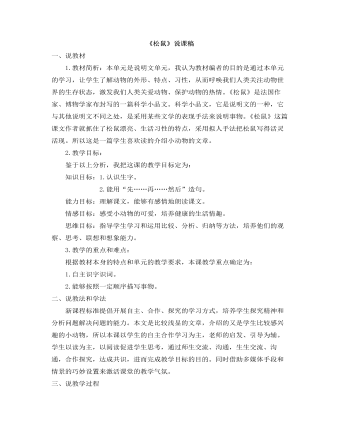
部编人教版五年级上册《 松鼠》说课稿
一、说教材 1.教材简析:本单元是说明文单元,我认为教材编者的目的是通过本单元的学习,让学生了解动物的外形、特点、习性,从而呼唤我们人类关注动物世界的生存状态,激发我们人类关爱动物、保护动物的热情。《松鼠》是法国作家、博物学家布封写的一篇科学小品文。科学小品文,它是说明文的一种,它与其他说明文不同之处,是采用某些文学的表现手法来说明事物。《松鼠》这篇课文作者就抓住了松鼠漂亮、生活习性的特点,采用拟人手法把松鼠写得活灵活现。所以这是一篇学生喜欢读的介绍小动物的文章。2.教学目标:鉴于以上分析,我把这课的教学目标定为:知识目标:1.认识生字。2.能用“先……再……然后”造句。能力目标:理解课文,能够有感情地朗读课文。情感目标:感受小动物的可爱,培养健康的生活情趣。
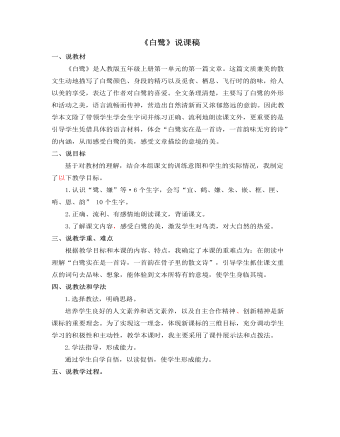
部编人教版五年级上册《白鹭》说课稿
一、说教材《白鹭》是人教版五年级上册第一单元的第一篇文章。这篇文质兼美的散文生动地描写了白鹭颜色、身段的精巧以及觅食、栖息、飞行时的韵味,给人以美的享受,表达了作者对白鹭的喜爱。全文条理清楚,主要写了白鹭的外形和活动之美,语言流畅而传神,营造出自然清新而又浓郁悠远的意韵。因此教学本文除了带领学生学会生字词并练习正确、流利地朗读课文外,更重要的是引导学生凭借具体的语言材料,体会“白鹭实在是一首诗,一首韵味无穷的诗”的内涵,从而感受白鹭的美,感受文章描绘的意境的美。二、说目标基于对教材的理解,结合本组课文的训练意图和学生的实际情况,我制定了以下教学目标。
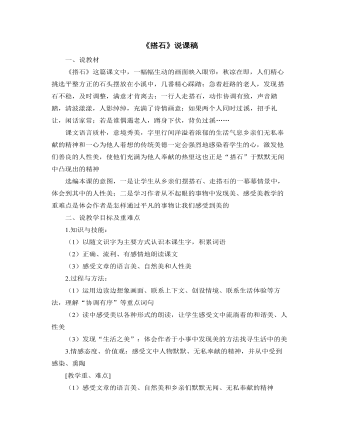
部编人教版五年级上册《搭石》说课稿
一、说教材《搭石》这篇课文中,一幅幅生动的画面映入眼帘:秋凉在即,人们精心挑选平整方正的石头摆放在小溪中,几番精心踩踏;急着赶路的老人,发现搭石不稳,及时调整,满意才肯离去;一行人走搭石,动作协调有致,声音踏踏,清波漾漾,人影绰绰,充满了诗情画意;如果两个人同时过溪,招手礼让,闲话家常;若是谁偶遇老人,蹲身下伏,背负过溪……课文语言质朴,意境秀美,字里行间洋溢着浓郁的生活气息乡亲们无私奉献的精神和一心为他人着想的传统美德一定会强烈地感染着学生的心,激发他们善良的人性美,使他们充满为他人奉献的热望这也正是“搭石”于默默无闻中凸现出的精神
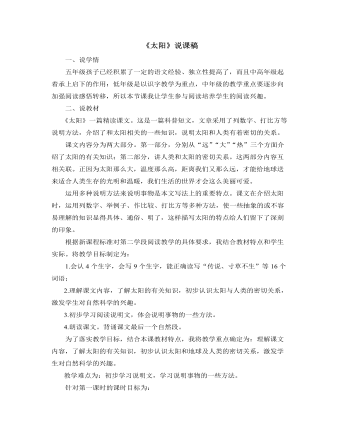
部编人教版五年级上册《太阳》说课稿
三、 说教法这是一篇说明文,它不是借助艺术形象传授知识的,而是在观察某些事物的基础上用准确、通俗的语言来说明事物传授知识的。所以我侧重以下几个方面来教的:1.抓住说明文的构段特点进行教学。教给学生学习方法,找出说明文在结构上注重一段一意,段首概括的规律,注重帮助学生理清文章的结构层次。2.抓住文中的语言,了解说明事物的方法。课文第一自然段为了讲清楚太阳的三个特点,运用了大量的数字来说明,给学生的感觉一目了然。但是为什么要引用传说,就是为了增加文章的生动性,这样教学既使学生了解了学法,又激发了学生学习兴趣。这样做的目的是,既教了课文,又学会了作者的写作方法。3.利用多媒体手段,激发学生的学习兴趣。说明文同记叙文相比,语言比较枯燥,形象性不强。在教学过程中,我制作了课件,变抽象为具体,激发学生主动学习的积极性,调动学生多种感官去接受知识,从而增强学习效果,是一举多得的方法。
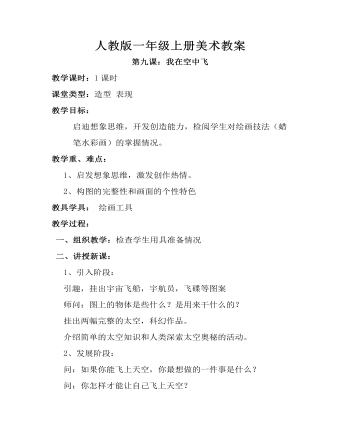
小学美术人教版一年级上册《第9课我在空中飞》教案
一、组织教学:检查学生用具准备情况二、讲授新课:1、引入阶段:引趣,挂出宇宙飞船,宇航员,飞碟等图案师问:图上的物体是些什么?是用来干什么的?挂出两幅完整的太空,科幻作品。介绍简单的太空知识和人类深索太空奥秘的活动。
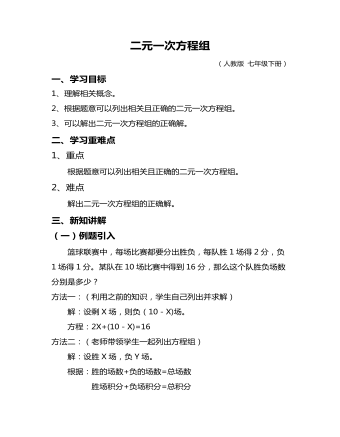
初中数学人教版二元一次方程组教学设计教案
(一)例题引入篮球联赛中,每场比赛都要分出胜负,每队胜1场得2分,负1场得1分。某队在10场比赛中得到16分,那么这个队胜负场数分别是多少?方法一:(利用之前的知识,学生自己列出并求解)解:设剩X场,则负(10-X)场。方程:2X+(10-X)=16方法二:(老师带领学生一起列出方程组)解:设胜X场,负Y场。根据:胜的场数+负的场数=总场数 胜场积分+负场积分=总积分得到:X+Y=10 2X+Y=16